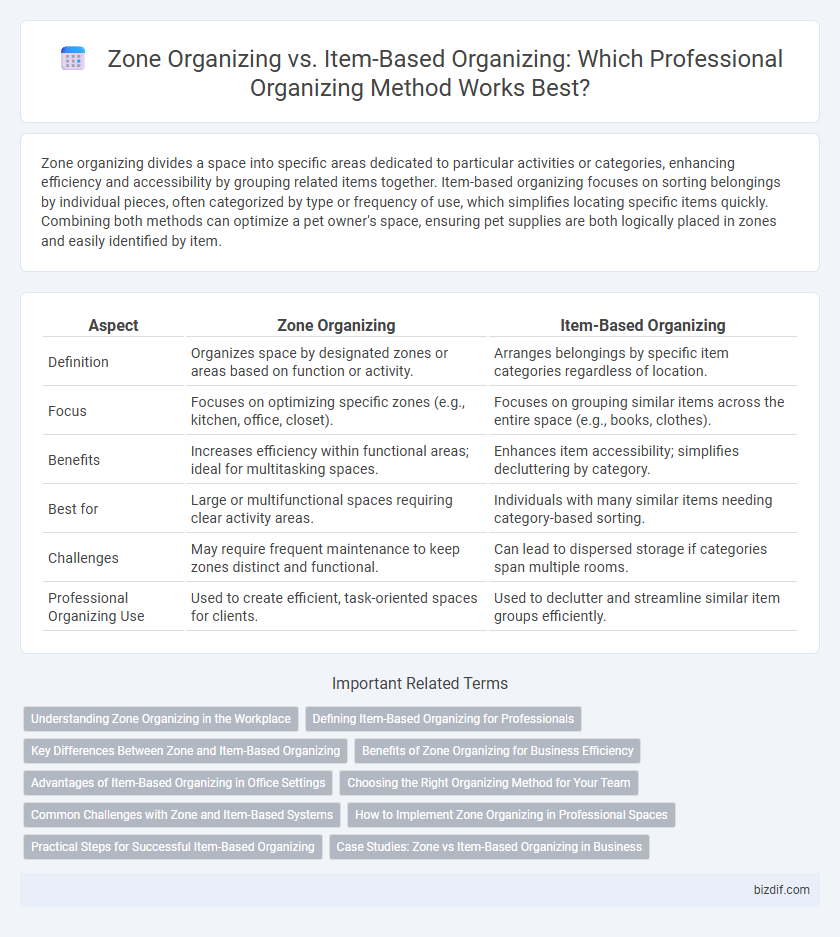Zone organizing divides a space into specific areas dedicated to particular activities or categories, enhancing efficiency and accessibility by grouping related items together. Item-based organizing focuses on sorting belongings by individual pieces, often categorized by type or frequency of use, which simplifies locating specific items quickly. Combining both methods can optimize a pet owner's space, ensuring pet supplies are both logically placed in zones and easily identified by item.
Table of Comparison
| Aspect | Zone Organizing | Item-Based Organizing |
|---|---|---|
| Definition | Organizes space by designated zones or areas based on function or activity. | Arranges belongings by specific item categories regardless of location. |
| Focus | Focuses on optimizing specific zones (e.g., kitchen, office, closet). | Focuses on grouping similar items across the entire space (e.g., books, clothes). |
| Benefits | Increases efficiency within functional areas; ideal for multitasking spaces. | Enhances item accessibility; simplifies decluttering by category. |
| Best for | Large or multifunctional spaces requiring clear activity areas. | Individuals with many similar items needing category-based sorting. |
| Challenges | May require frequent maintenance to keep zones distinct and functional. | Can lead to dispersed storage if categories span multiple rooms. |
| Professional Organizing Use | Used to create efficient, task-oriented spaces for clients. | Used to declutter and streamline similar item groups efficiently. |
Understanding Zone Organizing in the Workplace
Zone organizing in the workplace involves dividing spaces into specific functional areas, allowing employees to focus on designated zones for improved efficiency and clarity. This method enhances workflow by reducing clutter and streamlining access to tools and resources relevant to each zone. Unlike item-based organizing, which focuses on categorizing individual items, zone organizing supports task-oriented environments and promotes better spatial management.
Defining Item-Based Organizing for Professionals
Item-based organizing focuses on categorizing belongings by type, allowing professionals to systematically assess and sort each category for efficient storage solutions. This method enhances clutter reduction by grouping similar items, such as documents, clothing, or tools, facilitating easier access and maintenance. Organizing by item type supports tailored strategies that address specific needs, promoting long-term organization and client satisfaction.
Key Differences Between Zone and Item-Based Organizing
Zone organizing divides spaces into specific areas based on functions, such as a kitchen zone for cooking tools, enhancing efficiency by keeping related items together. Item-based organizing sorts belongings by category regardless of their location, like grouping all books in one area, which simplifies locating similar items across spaces. The key difference lies in zone organizing emphasizing spatial function, while item-based organizing prioritizes categorization by item type.
Benefits of Zone Organizing for Business Efficiency
Zone organizing enhances business efficiency by grouping related items or tasks within defined areas, minimizing time spent searching and streamlining workflow. This method supports quicker decision-making and reduces errors by maintaining a consistent, intuitive layout. By optimizing spatial utilization, zone organizing boosts productivity and fosters a more organized, focused work environment.
Advantages of Item-Based Organizing in Office Settings
Item-based organizing in office settings enhances efficiency by categorizing supplies and documents according to their specific purpose, enabling quicker retrieval and reducing time wasted searching for materials. This method promotes clear inventory management, ensuring essential items are consistently stocked and reducing clutter by eliminating unnecessary duplicates. Organizing by items also supports personalized workflows, as employees can arrange their workspaces to match individual needs and tasks, boosting productivity and comfort.
Choosing the Right Organizing Method for Your Team
Zone organizing enhances team efficiency by assigning specific areas for each member to manage, fostering accountability and reducing overlap. Item-based organizing allows individuals to focus on specific tasks or items, promoting expertise and detailed attention to particular components. Selecting the right method depends on your team's size, workflow complexity, and the nature of the tasks to optimize productivity and collaboration.
Common Challenges with Zone and Item-Based Systems
Zone organizing often leads to clutter buildup as items unrelated to the zone's primary function accumulate, causing confusion and inefficiency. Item-based organizing struggles with categorizing multipurpose objects, resulting in frequent misplacement and difficulty maintaining order. Both systems face challenges in adapting to evolving lifestyle needs and require regular reassessment to sustain long-term organization.
How to Implement Zone Organizing in Professional Spaces
Implementing zone organizing in professional spaces involves dividing the office into distinct functional areas based on activities, such as a dedicated zone for meetings, a zone for administrative tasks, and a zone for creative work. Each zone should have clearly labeled storage solutions and tools tailored to the specific tasks performed there, enabling efficient workflow and reducing time spent searching for items. Incorporating ergonomic furniture and keeping frequently used supplies within arm's reach further enhances productivity and maintains a clutter-free environment.
Practical Steps for Successful Item-Based Organizing
Effective item-based organizing begins with categorizing belongings by type, ensuring all items in one category are gathered and assessed simultaneously. Prioritize decluttering by evaluating each item's usefulness and sentimental value before choosing appropriate storage solutions tailored to the entire category. Consistently labeling and maintaining designated spaces for similar items promotes long-term order and accessibility.
Case Studies: Zone vs Item-Based Organizing in Business
Case studies in professional organizing reveal that zone organizing enhances workflow efficiency in business environments by grouping related tasks and materials within defined areas, reducing time spent searching for items. Item-based organizing, while effective in small-scale or inventory-focused settings, often leads to increased management complexity and decreased accessibility when applied to broader business operations. Data shows companies implementing zone organizing report up to 30% improvements in productivity and employee satisfaction compared to item-based methods.
zone organizing vs item-based organizing Infographic

 bizdif.com
bizdif.com